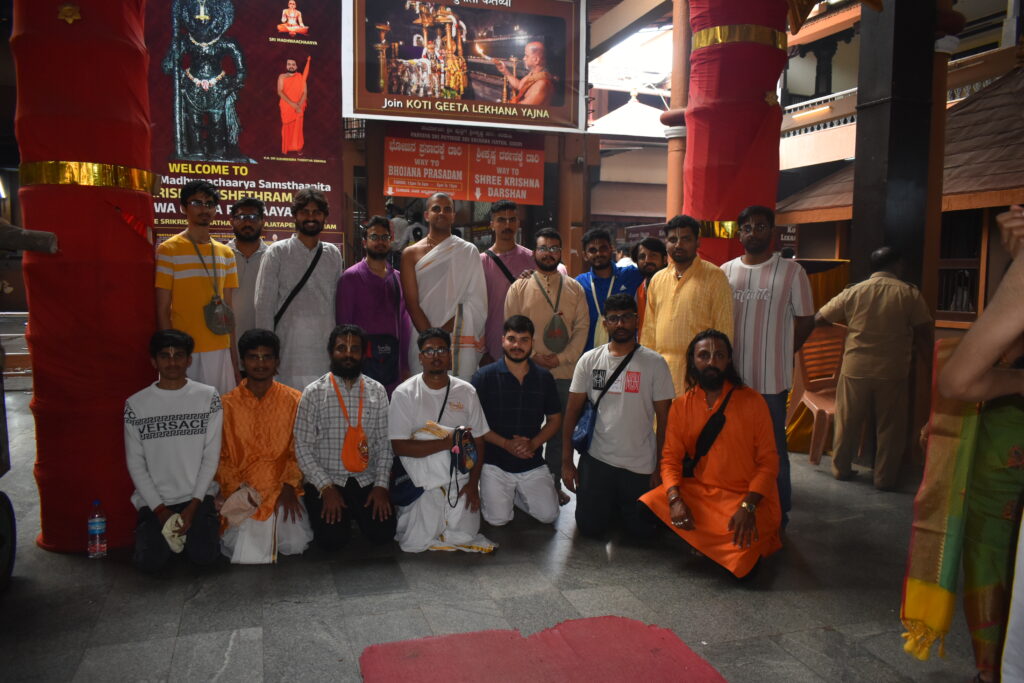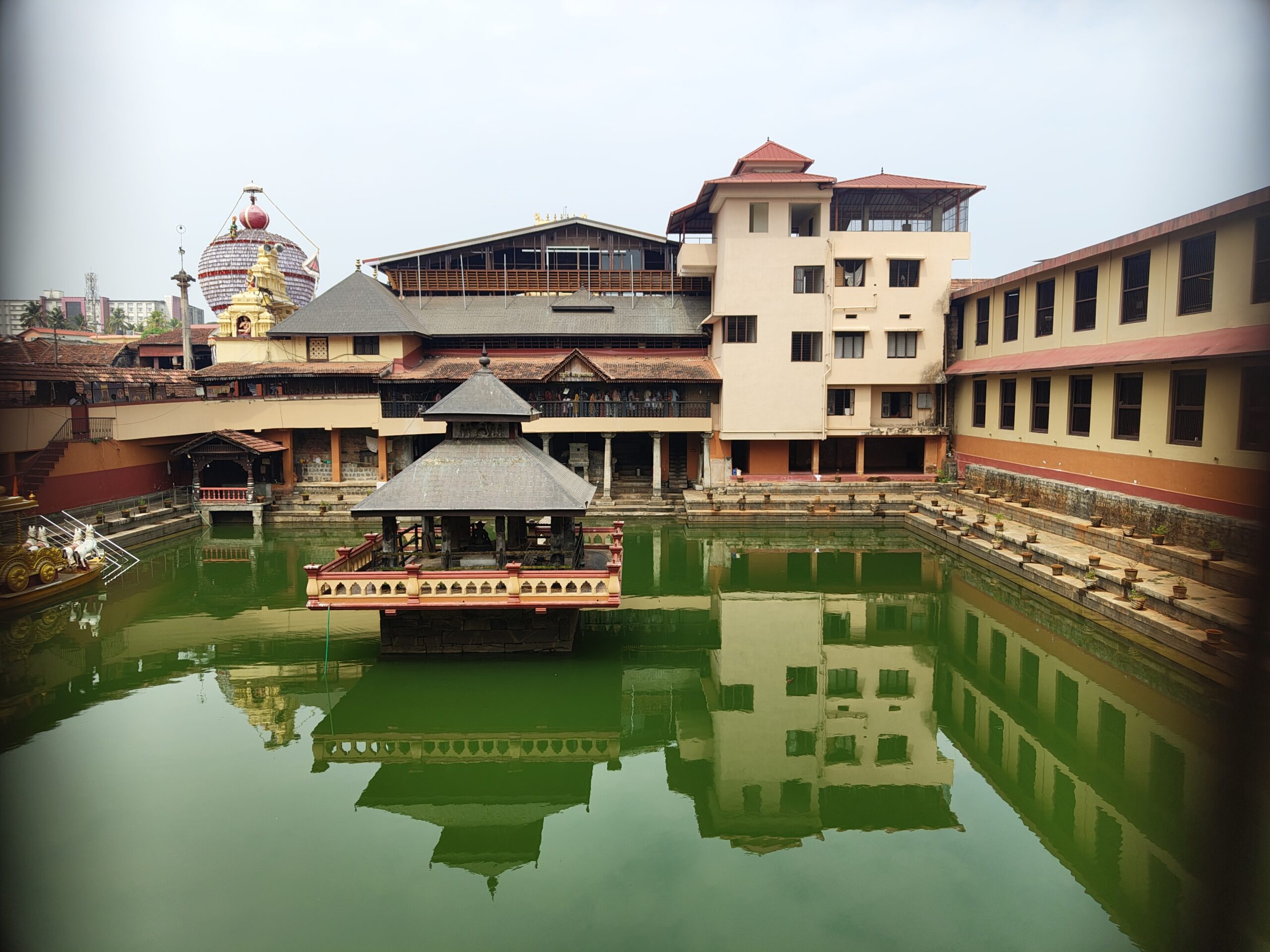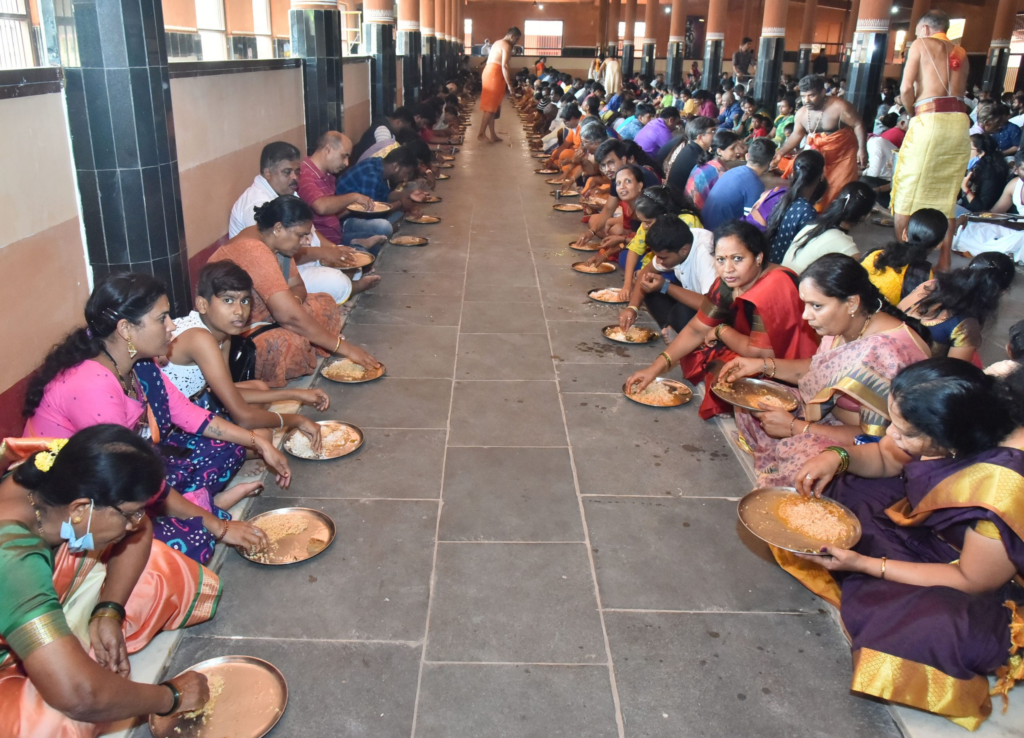Udupi Mangalore Spiritual Journey: As the evening of April 4th approached, excitement and anticipation filled the air.
Our journey to Udupi and Mangalore was about to begin—a pilgrimage infused with devotion, history, and spiritual enrichment.
The plan of Udupi Mangalore Spiritual Journey was simple yet profound: to visit the revered Sri Krishna Matha, explore the birthplace of the great saint Madhvacharya, engage in enlightening spiritual discussions, and culminate our experience by celebrating Rama Navami in Mangalore.
Also Read: Kanchipuram Travel Guide: My Spiritual Pilgrimage & Temple Experience
Our departure point of Udupi Mangalore Spiritual Journey was ISKCON Bangalore, where fellow travelers gathered, all sharing the same enthusiasm for this sacred voyage.

The energy was palpable as we prepared to embark on an overnight bus journey.
Luggage was packed, travel essentials checked, and warm farewells exchanged with friends and family.
As the bus rolled out of the city, the hum of devotional chants and conversations filled the space, setting a serene and uplifting tone for the journey ahead.
The road stretched before us, leading towards the coastal towns of Karnataka, where history and divinity intertwine seamlessly.
The night was young, and with every mile covered, we inched closer to an experience that promised to be transformative and memorable.
Key Benefits of a Spiritual Journey to Udupi and Mangalore
- 🛕 Connect with Ancient Heritage at Shri Krishna Matha and Pajaka Kshetra
- 🧘♂️ Deepen Personal Devotion through kirtans, darshans, and sacred rituals
- 🌊 Blend Spirituality with Nature at Malpe Beach and Kunjarugiri Hill
- 🍛 Relish Sattvic Meals & Prasadam at temples and ISKCON centers
- 🎉 Celebrate Rama Navami with grandeur in the heart of Mangalore
- 🧭 Discover Untapped Pilgrimage Spots like Chandramouleshwara and Kadri Temple
Challenges & Considerations
Navigating Lesser-Known Spots
While famous temples like Shri Krishna Matha are well-marked, places like Pajaka Kshetra and Kunjarugiri require planning.
Having local navigation or a guide can enhance your experience.
Balancing Travel & Spiritual Focus
Packing multiple temples and cultural activities in two days can be intense.
It’s important to plan breaks and factor in darshan queues.
How This Journey Impacts Devotees & Cultural Seekers
This trip blends introspection with inspiration.
For devotees, it’s a chance to reconnect with the divine in sacred geographies.
For cultural enthusiasts, the journey uncovers philosophical depth, Vedic architecture, and Bhakti-driven traditions in Karnataka’s spiritual capital.
Day 1 – Udupi: In the Land of Sri Madhvacharya
Shri Krishna Matha


The heart of Udupi’s spiritual landscape, Shri Krishna Matha is a legendary temple established by Sri Madhvacharya, the proponent of the Dvaita school of Vedanta.

The temple is renowned for its unique method of darshan — through a nine-holed window called Navagraha Kindi, from which devotees get a glimpse of Lord Krishna’s idol.

The idol itself is said to have been installed by Madhvacharya, retrieved from a shipwreck, and is adorned with sandalwood, jewels, and a peacock feather.

Throughout the day, the temple reverberates with soul-stirring kirtans, Vedic chants, and sevas.
The temple’s atmosphere is elevated during the Naivedya and Mangala Aarti, which are open for devotees to participate.
Don’t miss the Krishna prasadam, a sanctified meal served free of charge to hundreds daily.

The divine ambiance, rich heritage, and spiritual magnetism make this temple a centerpiece of any Udupi pilgrimage.
Pajaka Kshetra

Just a short drive from Udupi town lies Pajaka Kshetra, the holy birthplace of Sri Madhvacharya.
Tucked in a serene village, the place showcases several miracles associated with his childhood.
You can see the stone Madhvacharya lifted as a child, the house where he was born, and the footprint of Lord Vishnu, which is believed to have inspired Madhvacharya’s divine mission.

The sacred pond, or Vishnu Tirtha, used by Madhvacharya for his daily rituals, still remains an active place of pilgrimage.
The surrounding hills and countryside give it a deeply meditative environment.
It is also a scholarly hub where students study scriptures in traditional gurukul-style education, sustaining the legacy of Dvaita Vedanta.

Sri Parashurama Temple, Kunjarugiri
Located on Kunjarugiri Hill, the Sri Parashurama Temple offers not just a divine experience but also breathtaking views of the Udupi coastline.
Legend holds that Lord Parashurama reclaimed the land of the Konkan coast from the sea and established this temple.
The steep steps to the temple symbolize an ascent toward divinity.
The idol is a rare depiction of Lord Parashurama in a contemplative pose.
The temple is surrounded by four sacred ponds named after divine elements.
Visiting here at sunrise or sunset provides a surreal spiritual and visual experience, linking devotion with the elements of nature.
Sri Rajarajeshwari Temple
Situated in the heart of Udupi, this temple is dedicated to Goddess Rajarajeshwari, a powerful form of the Divine Mother.
A relatively quiet temple compared to Krishna Matha, it offers a tranquil space for inner contemplation and Devi sadhana.
The temple architecture follows traditional South Indian design with carved stone pillars, a sanctum filled with divine energy, and intricate sculptures adorning its walls.
Devotees come here for blessings of protection, wisdom, and strength, often lighting lamps and offering coconuts as part of their prayers.
Malpe Beach
Though not a temple, Malpe Beach provides a necessary recreational and spiritual reset. After a day of temple visits, a visit to this pristine, less-crowded beach is refreshing.
I enjoyed playing kabaddi with friends on the soft sand and took a rejuvenating dip in the Arabian Sea, which felt like a symbolic spiritual cleansing.
The sunset over the ocean, with fishing boats dotting the horizon, offered a poetic end to the day’s journey.
Nearby, one can also explore St. Mary’s Island, adding a touch of nature’s grandeur to the spiritual itinerary.
Chandramouleshwara Temple
Often overlooked due to its proximity to Krishna Matha, the Chandramouleshwara Temple is one of the oldest Shiva temples in Udupi.
The temple is believed to be over 1,000 years old and is made entirely of black stone.
Its simplicity is its strength — a small sanctum, no large crowds, and a deeply peaceful atmosphere.
The Shiva Lingam here is revered as self-manifested (Swayambhu), and locals visit regularly for evening aartis.
This temple reflects the Shaivite legacy of the region, complementing the Vaishnavite presence of Shri Krishna Matha.
Day 2 – Mangalore: Bhakti, Community & Celebration
Akshaya Patra Foundation & Proposed ISKCON Mangalore Temple
Day 2 of our Udupi Mangalore Spiritual Journey began with a visit to the Akshaya Patra Foundation’s new campus in Mangalore, a modern kitchen that provides mid-day meals to thousands of schoolchildren.
Located on the same premises is the proposed site for ISKCON Mangalore, envisioned to be a hub for spiritual education, kirtans, and prasadam distribution.
This fusion of service (seva) and spirituality exemplifies ISKCON’s modern approach to outreach — combining bhakti with tangible community benefit.
Shri Kshetra Kadri Temple
A cornerstone of Mangalore’s spiritual history, the Kadri Manjunatha Temple is a Shaivite temple with deep Buddhist roots.
It is home to an ancient bronze idol of Lokeshwara, believed to be one of the oldest of its kind in India.
The temple complex is known for its natural springs — Gomukha Teertha — which flows into nine sacred tanks.
Ritual bathing here is said to purify sins and rejuvenate health.
Its tranquil atmosphere, ancient inscriptions, and religious syncretism make it a fascinating stop on the pilgrimage.
ISKCON Sri Sri Krishna Balaram Mandir
The ISKCON temple in Mangalore is vibrant, energetic, and buzzing with devotional enthusiasm.
Inside, the beautifully adorned deities of Sri Krishna and Balaram are the center of daily aartis, bhajans, and Bhagavad-gita discourses.
What stood out was the community spirit — young volunteers leading kirtans, guests receiving prasadam, and the temple shop offering spiritual books and paraphernalia.
This ISKCON center is becoming a vital part of Mangalore’s devotional life.
Rama Navami Celebrations & Shobha Yatra
The highlight of the day was the Rama Navami festival organized by ISKCON Mangalore.
The temple came alive with devotional fervor — bhajans, Rama kirtans, cultural dramas, and inspiring discourses on Lord Rama’s life and teachings.
The Shobha Yatra (chariot procession) in the evening was a sight to behold.
Devotees pulled the ornately decorated ratha of Lord Rama through Mangalore’s main streets, accompanied by mridangam beats, kartal rhythms, and joyful dancing.
It was a powerful expression of collective bhakti, uniting people from all walks of life in celebration of dharma and devotion.
